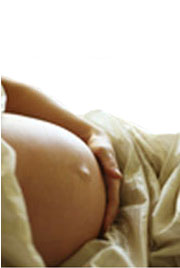- What is Placental Abruption (Abruptio Placentae)?
- Statistics
- Risk Factors
- Progression
- Symptoms
- Clinical Examination
- How is it Diagnosed
- Prognosis
- Treatment
- References
What is Placental Abruption (Abruptio Placentae)?
Placental abruption is defined as the premature separation of a normally positioned placenta. This results in bleeding which may be revealed (seen to come out through the vagina), in approximately two thirds of cases, or concealed (no visible blood loss), in approximately one third of cases. Abruption may be total, involving the whole placenta, or partial, where only a portion of the placenta is involved.
Placental abruption is an emergency so it is important to seek medical attention as soon as possible if you experience any vaginal blood loss or other symptoms. It is particularly important for you to seek medical attention for signs of vaginal bleeding within 24 hours if you have a rhesus negative blood group as you will need to be administered anti-D to avoid rhesus disease.
Statistics
Placental abruption affects approximately 1% of pregnancies. While abruption can occur in women with no risk factors, there are factors, listed below, that increase the risk of a mother experiencing placental abruption.
Risk Factors

- Disorders of blood pressure
- High parity
- Increased maternal age
- Low socioeconomic groups
- Prolonged preterm rupture of the membranes
- Polyhydramnios
- Following delivery of a first twin
- Trauma (e.g. fall; motor vehicle accident)
- Cigarette smoking (the more that is smoked, the more the risk is increased)
- Cocaine and drug use
- Preeclampsia
- Oligohydramnios
- Chorioamnionitis
Symptoms
The clinical presentation of placental abruption varies widely. Some mothers have no symptoms while others present with one or more of the classic triad of symptoms including abdominal pain, vaginal bleeding and uterine contractions. However, note that severe abruption can occur in the absence of any of these signs and is only found out following delivery of the placenta.
Other reported symptoms include backache, nausea, restlessness and faintness. Symptom severity depends on several factors including the location of the placenta, whether the bleeding is revealed (blood loss from the genital tract) or concealed (no evidence of bleeding from the genital tract), and the degree of abruption. Note that the volume of vaginal blood loss is a poor indicator of the degree of abruption.
Placental abruption also has the potential to affect your unborn child. Depending on the severity, your baby may be unaffected, distressed and be requiring urgent delivery or may be deceased. This will be determined by monitoring the baby’s heart rate.
Clinical Examination

Other than your health, they will also be concerned with the health of your unborn child. They will be interested in foetal movements, the foetal heart rate and how far along you are in the pregnancy. If there are any signs of fetal compromise, active bleeding, uterine activity or tenderness a cardiotocograph (CTG) will be applied for continuous monitoring.
Several blood tests will be ordered and an ultrasound may be necessary.
How is it Diagnosed
A diagnosis of placental abruption is made on clinical grounds. This means a decision is made based on the signs and symptoms reported and findings from the investigations performed.
Prognosis
Cases of placental abruption vary widely in severity and implications. Cases with minor bleeding may have little or no consequences, however more severe abruption can lead to foetal death and severe maternal morbidity and mortality. The risks to the mother primarily depend on the severity of the abruption. However, the risk to the foetus depends not only on the severity of the abruption but also the gestational age at which the abruption occurs.
As with most obstetric emergencies, we need to consider both the effects on the mother and the effects on the foetus.
Effects on the mother
The acute blood loss seen with placental abruption, depending on the severity, may result in:
- Hypovolaemic shock
- Disseminated intravascular coagulation (DIC)
- Acute renal failure
- Feto-maternal haemorrhage
In extreme cases, placental abruption may also result in maternal death, usually as a consequence of the above listed complications.
In subsequent pregnancies, the risk of placental abruption reoccurring is ~10% and increases to 25% following a second episode.
Effects on the foetus

In cases of chronic or recurrent abruption, the area of placenta available for nutrient and waste exchange is reduced, which may lead to intrauterine growth restriction.
Treatment

All women with placental abruption require intravenous fluids as even with large blood losses, pulse and blood pressure can remain within normal limits.
Women in shock require immediate, rapid intravenous fluid therapy and possibly a blood transfusion. Their urinary output is also carefully monitored.
The stability of the mother is the priority. This means that in cases where the foetus is alive and delivery is urgent, accelerated delivery should not compromise the mother’s resuscitation. In many cases, a caesarean section will be required. In severe cases where the foetus has died, delivery is delayed until the mother is stable. Once stable, and in the absence of other contraindications, vaginal delivery can be allowed.
In cases where both the mother and the foetus’ status is reassuring, conservative management with the aim of a vaginal delivery can be weighed against more urgent delivery. For those at or near term, if labour is established it will be allowed to progress. If labour is not established, induction may be considered. In both cases, the mother and foetus are monitored closely throughout the entirety of the labour. If the foetus becomes distressed or if the mother’s condition deteriorates, prompt delivery by cesarean section is required.
For those where gestational age is preterm (between 20 and 34 weeks gestation), conservative management allows for a delayed delivery and increased foetal maturity. However, due to the significant risk of foetal death, conservative management involves close monitoring of several parameters using ultrasound. Steroids to promote foetal lung maturation are administered for those with gestational ages between 24 and 34 weeks.
Parents will be counseled by a neonatologist about the potential outcomes and treatments. Delivery will need to take place in a centre with adequate neonatal facilities. The decision for conservative management should weigh up the perceived risks for delaying delivery against the risks of premature delivery.
Management in subsequent pregnancy

Women in this situation are encouraged to minimise exposure to those predisposing factors that are within our control, particularly cocaine and tobacco use. Prior to the next pregnancy it is also important to have good blood pressure control in those with hypertension.
It would be reasonable in subsequent pregnancies to increase the frequency of ultrasounds in the second half of the pregnancy to monitor foetal growth. If a mother has a history of two or more prior abruptions, amniocentesis for lung maturity and delivery at 37 weeks gestation may be carried out.
References
- Baskett TF. Essential management of obstetric emergencies. 4th ed. 2004. Clinical Press Limited, Redland, Bristol.
- Baker PN (Ed). Obstetrics by ten teachers. 18th ed. 2006. Edward Arnold, New York, New York.
- Oyelese Y, Ananth CV. Placental Abruption. Obstet Gynecol 2006; 108: 1005-16.
- Bernis K, Gille J. Placental pathology and asphyxia. In: Gluck L, editor. Intrauterine asphyxia and the developing foetal brain. Chicago (IL): Yearbook Medical Publishers; 1977.
- Gibbs JM, Weindling AM. Neonatal intracranial lesions following placental abruption. Eur J Pediatr 1994; 153: 195-7.
- KEMH clinical guidelines B 2.3.1 Management of a woman with an APH. April 2009. Available from: < http://www.wnhs.health.wa.gov.au/development/manuals/O&G_guidelines/sectionb/2/b2.3.1.pdf> [10 September 2009].
All content and media on the HealthEngine Blog is created and published online for informational purposes only. It is not intended to be a substitute for professional medical advice and should not be relied on as health or personal advice. Always seek the guidance of your doctor or other qualified health professional with any questions you may have regarding your health or a medical condition. Never disregard the advice of a medical professional, or delay in seeking it because of something you have read on this Website. If you think you may have a medical emergency, call your doctor, go to the nearest hospital emergency department, or call the emergency services immediately.







